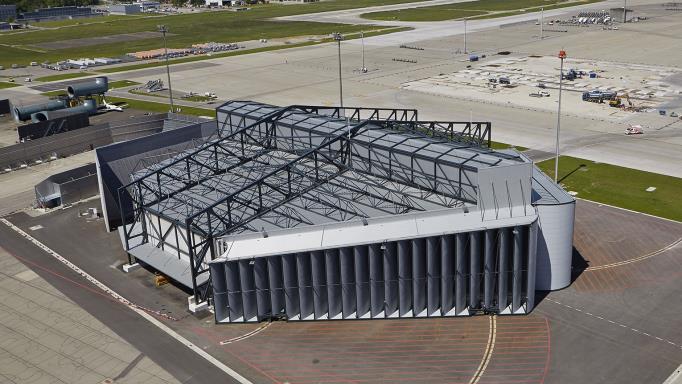


Noise can be menacing around the airport, for those living in the poximity ! Apart from the noise of take offs and landings, another source of noise is aircraft maintenance high power engine run ( take off thrust ).
And most of them take place during night hours ,which is worrisome. To take care of such noise , here we have a solution in the form of a hangar, specifically designed to contain the noise of such activities.
Maintenance agencies or airlines operating at Zurich Airport have a dedicated and specially designed hangar for this purpose , that replaces the previous noise baffles (mufflers), which were no longer state-of-the-art.
Flughafen Zürich AG's new noise protection hangar is a state-of-the-art facility that offers residents in nearby communities optimum protection against the noise of aircraft engine testing.
The Noise protection hangar was completed after a 20-month construction period in mid-June 2014 and commenced operations after a six-week training and test phase on 1 August 2014.
The noise protection hangar is built to let air through while reducing noise at the same time. It can accommodate aircraft up to the size of a Boeing 747-8 with a wing span of 68.5 metres and can thus be used by all aircraft types which are serviced regularly at Zurich Airport.
The hangar comprises the following main components: a support-free hall, a control room, doors and a steering element. The entire roof will be supported by an external, multi-coated steel construction consisting of both raised and flat grids as well as support elements across a maximum span of approx. 78 m.
The hangar is 111 metres long when the doors are closed and 126 metres long when they are open.
The interior height ranges from 12 metres at the side walls to 16 metres in the centre. A 10-metre-wide transverse element in the centre can accommodate the vertical stabilisers on long-haul aircraft (height 24 metres).
The hangar itself and the door tracks are supported with pillars that are 42 metres long. All interior surfaces in the hangar must be fitted with highly effective acoustic cladding. This is achieved by the use of perforated plate cassettes.
The jet blast deflector at the rear of the hangar is 16 metres high and has a flat construction. It serves to redirect the high-speed air emissions up at an angle of 90° and is also clad with sound-insulating plates.
Due to the restricted space for the Vertival stabilizer, the movement inside the hangar needs efforts and experience !
In this picture you can nicely see the unique architecture of Zurich airport’s silencer. The gap on the top is needed for the 330/340 and the 777. It’s also what makes it so challenging to park the plane, because we have almost no room for leaving the line marked on the floor. pic.twitter.com/Cgtim4PLmX
— Michael Ettlin (@ZRHworker) May 3, 2021
| Converted space (SIA 416): | 82,600 m³ |
| Height: | Max. 26 m (roof height) |
| New-build area: | 5,200 m² |
| Length (closed) x width: | 111m x 82m |
| Construction start: | October 2012 |
| Construction completion: | June 2014 |
| Operational start: | August 2014 |
Source : Zurich Airport.
